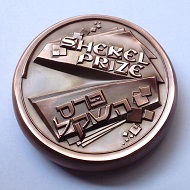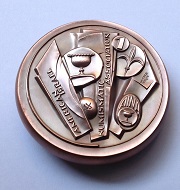October 12, 2017 – The Board Of Directors of the American Israel Numismatic Association (AINA) has created the Shekel Prize, that will be given annually to the author of the best book published on the subject of Ancient Judaean, Holy Land, Israel, or Jewish Numismatics. The judging committee consists of Mel Wacks, David Hendin, Ira Rezak, Steve Album and Allen Berman.
Shekel Prize of the AINA.
The Shekel Prize is an extremely high relief 3-inch medal designed by Victor Huster of Baden-Baden. Featured are three shekel designs – from a c. 8th century BCE shekel stone weight, a shekel of the First Revolt (66-70 CE), and 1-new shekel (issued by Israel beginning in 1985).
Yoav Farhi, winner of the first Shekel Prize.
The first winner is Yoav Farhi, author of “Khirbet Qeiyafa Vol. 5: Excavation Report 2007-2013, The Numismatic Finds: Coins and Related Objects.” Other contributors to this volume are C. Lorber, S. Shalev and S. Shilstein. The Shekel Prize medal will be presented to Yoav later this year in a ceremony in Israel.
This is Farhi’s first book. His MA thesis (2004) was “The Coinage of the City of Lod (Diospolis) from the Roman Period to the End of the Early Islamic Period” (Hebrew), and Farhi’s Doctoral Dessertation was Doctoral Dissertation (2013) was “The Coinage of Gaza in the Roman Period (1st Century BCE-3rd Century CE).”
The winning book’s content is described by the publisher, The Israel Exploration Society:
“More than 600 coins and related objects were found at Khirbet Qeiyafa during the 2007-2013 excavation seasons. The earliest coins date from the end of the sixth century BCE and the latest from the British Mandate. These coins almost all relate to three phases in the history of the site following the Iron Age occupation: the Late Persian-Early Hellenistic period (late fourth-early third centuries BCE), the Hasmonaean period up to the destruction of the Second Temple (first century BCE-first century CE) and the Late Roman and Byzantine periods (fourth-fifth centuries CE).
The numismatic finds from the Late Persian-Early Hellenistic period are extraordinary in their amount and rarity and include many types that were hitherto unknown from controlled excavations. The variety of coins that were found – imported Archaic and Classical Greek coins, coins from Phoenicia, local coins from mints in Jerusalem, Philistia, Samaria and possibly Edom, as well as Macedonian and Ptolemaic coins – contributes a great deal to our knowledge of the monetary economy of Judaea and its neighbours during the transition from the Persian to the Hellenistic period.
The exposure of this stratum and its numerous small finds is of great significance for the study of the transition from the Persian to the Hellenistic period in this region, since no site exposed so far in Israel in general, or in this region in particular, contains a comparable single-period occupation stratum that can be so precisely dated to this period.”
Other publications in the running for the 2017 Shekel Prize were “Jewish History in the Bible Portrayed in Coins” by Dr. John G. Leslie and “The New York Sale Auction XXXIX of Ancient Coins Featuring The Brody Family Collection of Ancient Jewish Coins” cataloged by Ira & Larry Goldberg Auctioneers, Baldwin’s, Dmitry Markov, and M & M Numismatics Ltd.
To go to the AINA website, please click here.
This is Yoav Farhi’s profile at academia.edu.
And information on Victor Huster and his creations can be obtained from his website.







